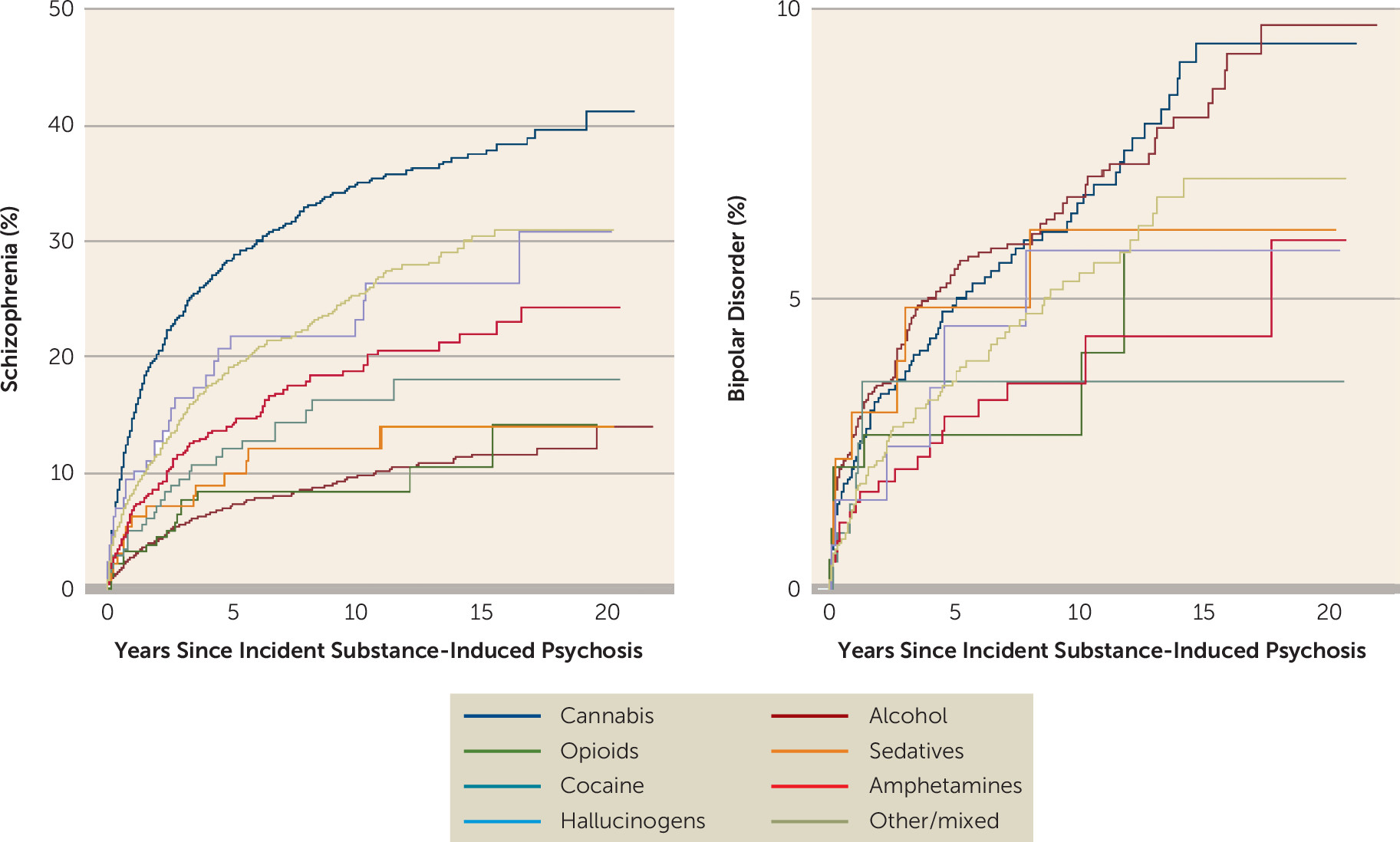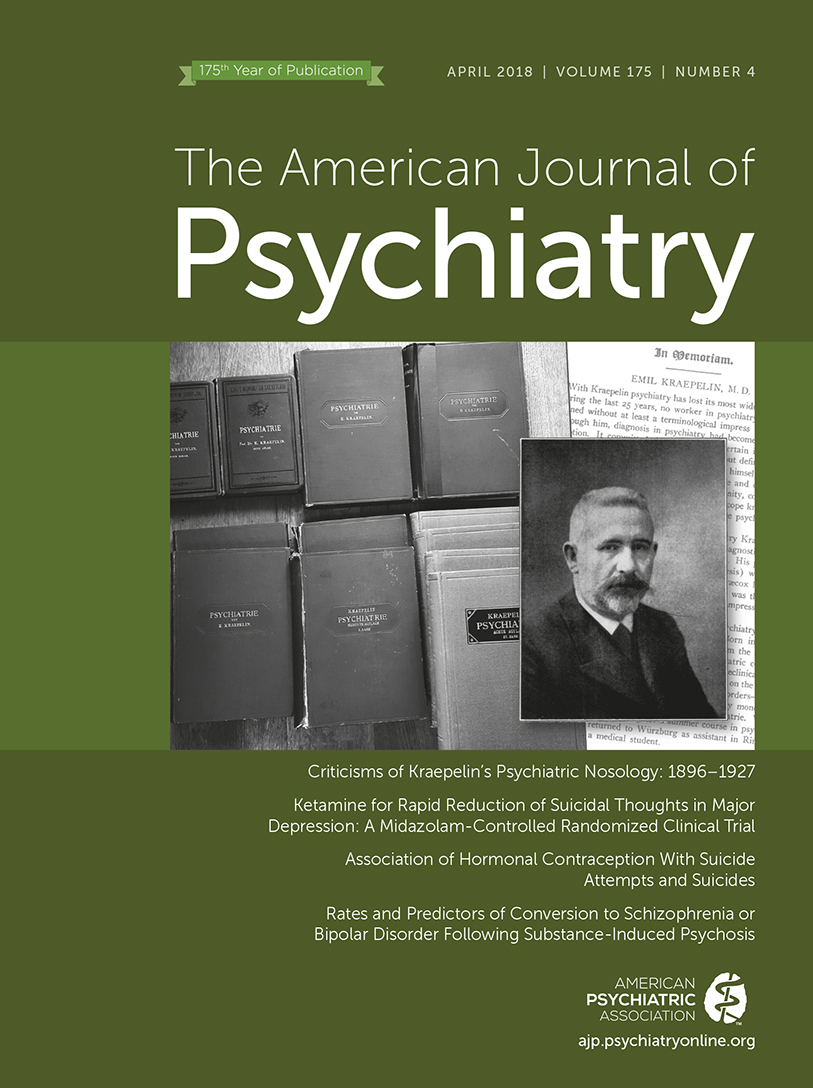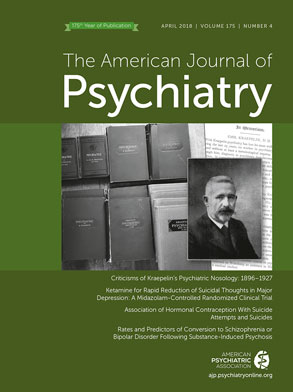Rates and Predictors of Conversion to Schizophrenia or Bipolar Disorder Following Substance-Induced Psychosis
Abstract
Objective:
Method:
Results:
Conclusions:
Method
Register
Population
Outcomes and Predictors
Statistical Analysis
Results
| Men | Women | All | ||||
|---|---|---|---|---|---|---|
| Substance and Earlier Diagnoses | N | % | N | % | N | % |
| Substance-induced psychosis | 5,078 | 74.8 | 1,710 | 25.2 | 6,788 | 100.0 |
| Alcohol | 1,680 | 33.8 | 635 | 37.1 | 2,315 | 34.1 |
| Opioids | 88 | 1.7 | 70 | 4.1 | 158 | 2.3 |
| Cannabis | 1,222 | 24.1 | 270 | 15.8 | 1,492 | 22.0 |
| Sedatives | 33 | 0.7 | 87 | 5.1 | 120 | 1.8 |
| Cocaine | 136 | 2.7 | 34 | 2.0 | 170 | 2.5 |
| Amphetamines | 423 | 8.3 | 132 | 7.7 | 555 | 8.2 |
| Hallucinogens | 91 | 1.8 | 23 | 1.4 | 114 | 1.7 |
| Mixed or other substances | 1,405 | 27.7 | 459 | 26.8 | 1,864 | 27.5 |
| Earlier diagnoses | ||||||
| Substance use disorder | 759 | 44.4 | 2,179 | 42.9 | 2,938 | 43.3 |
| Attention deficit hyperactivity disorder | 154 | 3.0 | 28 | 1.6 | 182 | 2.7 |
| Personality disorder | 831 | 16.4 | 464 | 27.1 | 1,296 | 19.1 |
| Unipolar depression | 426 | 8.4 | 262 | 15.3 | 688 | 10.1 |
| Anxiety disorder | 210 | 4.1 | 144 | 8.4 | 354 | 5.2 |
| Autism | 25 | 0.5 | 3 | 0.2 | 28 | 0.4 |
| Eating disorder | 4 | 0.1 | 43 | 2.5 | 47 | 0.7 |
| Self-harm before psychosis | 1,165 | 22.9 | 592 | 34.6 | 1,757 | 25.9 |
Proportion of Patients Converting to Psychotic Conditions


Risk of Conversion in Case Subjects Relative to Comparison Subjects
| Schizophrenia | Bipolar Disorder | |||||||
|---|---|---|---|---|---|---|---|---|
| Group | N | Hazard Ratio | 95% CI | p | N | Hazard Ratio | 95% CI | p |
| Comparison subjects | 200 | 1 (ref.) | 188 | 1 (ref.) | ||||
| Patients with substance-induced psychosis that later converted | 1,174 | 77.3 | 65.2–91.7 | <0.001 | 361 | 24.4 | 20.1–29.6 | <0.001 |
| Substance inducing the psychosis | ||||||||
| Alcohol | 183 | 74.0 | 48.4–113.3 | <0.001 | 144 | 28.4 | 20.6–39.3 | <0.001 |
| Opioids | 12 | 23.4 | 8.2–66.5 | <0.001 | 7 | 13.6 | 4.3–43.0 | <0.001 |
| Cannabis | 433 | 101.7 | 74.1–139.7 | <0.001 | 90 | 32.5 | 21.1–50.0 | <0.001 |
| Sedativesa | 13 | 7 | 33.0 | 6.9–159.0 | <0.001 | |||
| Cocaine | 22 | 43.0 | 16.3–113.6 | <0.001 | 5 | 12.2 | 3.3–45.5 | <0.001 |
| Amphetamines | 97 | 79.3 | 43.5–144.5 | <0.001 | 20 | 17.4 | 8.3–36.4 | <0.001 |
| Hallucinogens | 23 | 56.2 | 19.4–162.5 | <0.001 | 6 | 20.0 | 5.0–80.0 | <0.001 |
| Mixed or other substances | 391 | 67.2 | 50.9–88.8 | <0.001 | 82 | 18.7 | 12.9–27.0 | <0.001 |
Predictors of Conversion
| Schizophrenia | Bipolar disorder | |||||||
|---|---|---|---|---|---|---|---|---|
| Variable | Converted (N) | Hazard Ratio | 95% CI | p | Converted (N) | Hazard Ratio | 95% CI | p |
| Substance inducing the psychosis | ||||||||
| Alcohol | 183 | 1 (ref.) | 144 | 1 (ref.) | ||||
| Opioids | 12 | 0.78 | 0.43–1.40 | 0.40 | 7 | 0.72 | 0.34–1.55 | 0.41 |
| Cannabis | 433 | 2.17 | 1.77–2.66 | <0.001 | 90 | 1.49 | 1.07–2.08 | 0.02 |
| Sedatives | 13 | 1.94 | 1.10–3.42 | 0.02 | 7 | 0.67 | 0.31–1.44 | 0.30 |
| Cocaine | 22 | 0.84 | 0.54–1.33 | 0.47 | 5 | 0.70 | 0.28–1.76 | 0.45 |
| Amphetamines | 97 | 1.23 | 0.94–1.61 | 0.12 | 20 | 0.83 | 0.50–1.37 | 0.46 |
| Hallucinogens | 23 | 1.28 | 0.82–1.98 | 0.28 | 6 | 1.24 | 0.53–2.87 | 0.62 |
| Mixed or other substances | 391 | 1.48 | 1.21–1.81 | <0.001 | 82 | 0.93 | 0.68–1.27 | 0.65 |
| Earlier diagnoses | ||||||||
| Substance use disorder | 467 | 1.19 | 1.05–1.37 | 0.009 | 191 | 1.08 | 0.85–1.38 | 0.52 |
| Attention deficit hyperactivity disorder | 31 | 1.02 | 0.71–1.46 | 0.93 | 7 | 1.27 | 0.59–2.74 | 0.54 |
| Personality disorder | 229 | 1.29 | 1.09–1.52 | 0.002 | 115 | 1.46 | 1.13–1.89 | 0.004 |
| Unipolar depression | 106 | 1.10 | 0.89–1.36 | 0.36 | 77 | 2.03 | 1.54–2.67 | <0.001 |
| Anxiety disorder | 45 | 0.95 | 0.70–1.29 | 0.73 | 38 | 1.59 | 1.11–2.27 | 0.01 |
| Autism | ≤4a | 0.41 | 0.13–1.27 | 0.12 | ≤4a | 1.04 | 0.14–7.64 | 0.97 |
| Eating disorder | 17 | 1.73 | 1.05–2.87 | 0.03 | ≤4a | 0.75 | 0.27–2.07 | 0.58 |
| Self-harm before substance-induced psychosis | 177 | 0.80 | 0.68–0.95 | 0.01 | 80 | 0.95 | 0.72–1.24 | 0.71 |
| Self-harm after substance-induced psychosis | 124 | 1.92 | 1.58–2.34 | <0.001 | 40 | 1.60 | 1.13–2.27 | 0.008 |
| Age at incident substance-induced psychosis (years) | ||||||||
| ≤15 | 11 | 0.36 | 0.20–0.66 | 0.001 | 0 | |||
| 16–25 | 639 | 1 (ref.) | 103 | 1 (ref.) | ||||
| 26–30 | 179 | 0.74 | 0.63–0.88 | 0.001 | 38 | 0.99 | 0.68–1.44 | 0.96 |
| 31–35 | 119 | 0.59 | 0.48–0.73 | <0.001 | 30 | 0.87 | 0.57–1.32 | 0.51 |
| 36–40 | 99 | 0.60 | 0.47–0.75 | <0.001 | 32 | 1.05 | 0.68–1.61 | 0.82 |
| 41–50 | 102 | 0.32 | 0.25–0.40 | <0.001 | 71 | 1.14 | 0.79–1.64 | 0.48 |
| ≥51 | 29 | 0.12 | 0.08–0.18 | <0.001 | 87 | 1.69 | 1.16–2.44 | 0.006 |
| Male | 980 | 1.58 | 1.35–1.86 | <0.001 | 228 | 0.68 | 0.54–0.85 | 0.001 |
Discussion
Substance-Induced Psychosis as a Risk Factor
Cannabis and Schizophrenia
Conversion to Bipolar Disorder
Risk Factors for Conversion
Implications
Strengths and Limitations
References
Information & Authors
Information
Published In
History
Keywords
Authors
Funding Information
Metrics & Citations
Metrics
Citations
Export Citations
If you have the appropriate software installed, you can download article citation data to the citation manager of your choice. Simply select your manager software from the list below and click Download.
For more information or tips please see 'Downloading to a citation manager' in the Help menu.
View Options
View options
PDF/EPUB
View PDF/EPUBLogin options
Already a subscriber? Access your subscription through your login credentials or your institution for full access to this article.
Personal login Institutional Login Open Athens loginNot a subscriber?
PsychiatryOnline subscription options offer access to the DSM-5-TR® library, books, journals, CME, and patient resources. This all-in-one virtual library provides psychiatrists and mental health professionals with key resources for diagnosis, treatment, research, and professional development.
Need more help? PsychiatryOnline Customer Service may be reached by emailing [email protected] or by calling 800-368-5777 (in the U.S.) or 703-907-7322 (outside the U.S.).

